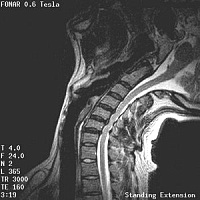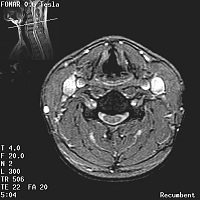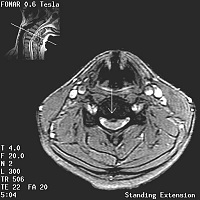UPRIGHT
DYNAMIC MRI
REVEALS OCCULT DISC HERNIATION
"This
MRI unit is important in that it enables the medical imaging
specialist to uncover significant occult disease that is not
apparent on the recumbent MRI studies"
J. Randy Jinkins, MD, FACR, FEC
Clinical
Case Overview
37 year-old male with bilateral pain and tingling in hands
exacerbated upon flexion of the cervical spine.
Case Study
The images shown below were acquired on the Fonar Stand-Up™
MRI. The sagittal image in Figure 1 was acquired with the
patient in a conventional recumbent position; Figure 2 is
of the same patient, but in a standing position during extension.
The standing-extension image demonstrates marked stenosis
of the central spinal canal resulting from posterior disc
protrusions extending into the anterior aspect of the spinal
canal and focal ligamentous infolding posteriorly. Note that
the resulting compression of the underlying spinal cord is
not evident on the recumbent scan. (Scanning parameters for
sagittal scans: TR= 3000 msec; TE = 160 msec; ETL = 15; 4.0
mm slice; scan time: 2:55 min - recumbent, 3:19 min - standing
extension.)

Figure 1: Sagittal T2-weighted
fast spin echo (FSE)
image in recumbent position

Figure 2: Sagittal T2-weighted
FSE
image in standing position during extension
The gradient recalled echo T2*-weighted
axial images are from the same patient. The standing extension
image (Figure 4) demonstrates a focal posterior disc herniation
at C4/5 level that is not visible on the recumbent scan (Figure
3). Patient positioning and dynamic maneuvers clearly play
a critical role in detecting clinically significant spinal
pathology. Note that a final diagnosis based only on the recumbent
scan would result in a missed pathologic diagnosis. (Scanning
parameters for axial scans: TR = 506 msec; TE = 22 msec; FA
= 20º; 4.0 mm slice; scan time: 5:04 min.)

Figure 3: Axial T2*-weighted
gradient recalled echo (GRE) image of patient in recumbent
position

Figure 4: Axial
T2*-weighted GRE image of patient in standing-extension
Diagnosis
Fluctuating intervertebral disc herniation dependent upon
patient position and dynamic physical maneuver.
Professor
J. Randy Jinkins, MD, FACR, FEC
Department of Radiology
Downstate Medical Center
State University of New York
450 Clarkson Avenue
Brooklyn, NY 11203
USA
Clinical Studies performed at:
Melville MRI - Long Island
close
this window
|
